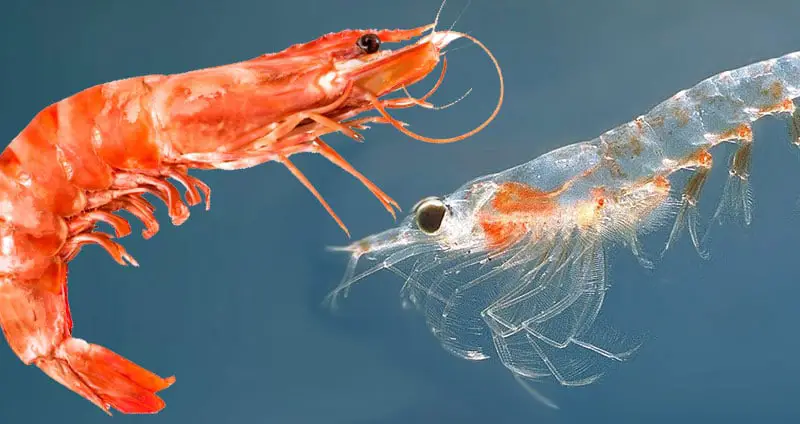Hey there! I’m Sarah from Krill Arctic Foods, and today we’re gonna dive deep into one of the most common questions we get: are krill and shrimp actually the same thing?
Spoiler alert Nope, they’re not! Even tho they might look like cousins at first glance, these little sea creatures are pretty different Let me break it down for you in a way that’s easy to understand
The Quick Answer
Krill and shrimp are different crustaceans
- Krill belong to the Euphausiacea order
- Shrimp belong to the Decapoda order
- They have different sizes, habitats, and uses
Size Matters: The Big (and Small) Differences
Let me tell ya about their sizes
Krill:
- Tiny fellows, usually up to 2 inches long
- Almost see-through (like a ghost in the water!)
- Got this cool superpower: they can glow in the dark!
Shrimp:
- Way bigger, ranging from 1 to 12 inches
- More colorful with obvious segments
- No glow-in-the-dark tricks here!
Where Do These Little Guys Live?
Krill’s Neighborhood:
- Love the cold water (especially Antarctic waters)
- Form massive swarms that stretch for miles
- Basically the underwater equivalent of a buffet for whales and penguins
Shrimp’s Hood:
- More flexible with their living situation
- Found in:
- Oceans
- Rivers
- Lakes
- Even brackish waters
- Pretty much global citizens!
What’s on Their Menu?
Krill’s Diet:
- Picky eaters – mostly stick to phytoplankton
- Filter feeders (like tiny underwater Roombas)
- Help keep ocean nutrients balanced
Shrimp’s Diet:
- Total foodies – they’ll eat almost anything
- Menu includes:
- Plants
- Small fish
- Algae
- Even leftover ocean stuff
How Long Do They Live?
Krill:
- Live about 5-7 years
- Reproduce by releasing eggs into water
- Form huge swarms with billions of buddies
Shrimp:
- Can live 1-7 years depending on species
- Carry their eggs under their bellies
- More spread out, less swarmy
Commercial Uses (This is Where It Gets Interesting!)
Krill:
- Mainly harvested for krill oil (loaded with those awesome Omega-3s)
- Used in health supplements
- Better absorbed by our bodies than fish oil
Shrimp:
- The seafood superstar!
- Used in tons of dishes worldwide
- High in protein but lower in Omega-3s
Environmental Impact (Yeah, We Gotta Talk About This)
Krill:
- Super important for ocean ecosystems
- Strict fishing regulations
- Overfishing could mess up whale and penguin food supply
Shrimp:
- Farming can harm mangrove forests
- Water pollution issues
- Working on more sustainable practices
Health Benefits Breakdown
Krill:
- Omega-3 powerhouse
- Low mercury levels
- Contains astaxanthin (fancy antioxidant)
Shrimp:
- Protein-packed
- Good source of:
- Vitamin B12
- Selenium
- Phosphorus
- Lower in calories
Our Take on This
At Krill Arctic Foods, we’ve seen lots of confusion about krill and shrimp. While they might look similar, they’re totally different creatures with their own special qualities. Whether you’re looking for health supplements (go krill!) or a tasty dinner (shrimp’s your friend!), now you know exactly what you’re getting!
FAQ (Cuz Y’all Keep Asking!)
Q: Do krill taste like shrimp?
A: Nah, krill are milder and more delicate.
Q: Are krill just baby shrimp?
A: Nope! Totally different species.
Q: Can I eat krill?
A: Yep! They’re safe and super nutritious.
Q: If I’m allergic to shrimp, can I have krill?
A: Better safe than sorry – avoid both if you’re allergic to shellfish.
So there ya have it! Next time someone asks you if krill and shrimp are the same, you can hit ’em with all these facts! Got more questions? Drop ’em in the comments below or reach out to us at Krill Arctic Foods – we’re always happy to chat about our favorite ocean creatures!
Would you like me to explain or break down any part of this article further?

It’s here: the NEW Britannica Kids website!
We’ve been busy, working hard to bring you new features and an updated design. We hope you and your family enjoy the NEW Britannica Kids. Take a minute to check out all the enhancements!
- The same safe and trusted content for explorers of all ages.
- Accessible across all of todays devices: phones, tablets, and desktops.
- Improved homework resources designed to support a variety of curriculum subjects and standards.
- A new, third level of content, designed specially to meet the advanced needs of the sophisticated scholar.
- And so much more!
